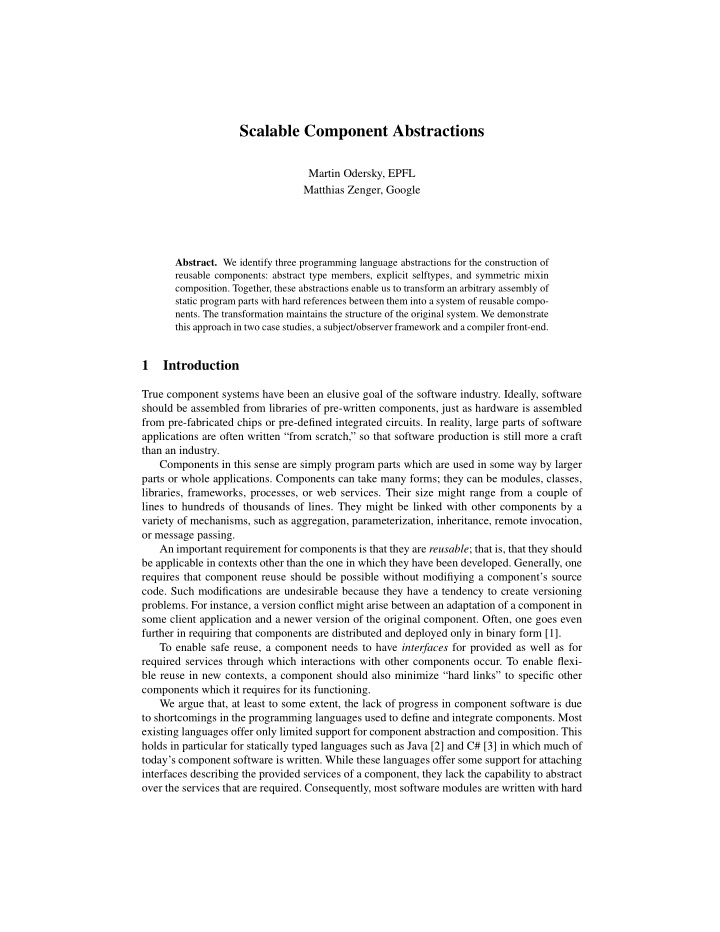



Scalable Component Abstractions Martin Odersky, EPFL Matthias Zenger, Google Abstract. We identify three programming language abstractions for the construction of reusable components: abstract type members, explicit selftypes, and symmetric mixin composition. Together, these abstractions enable us to transform an arbitrary assembly of static program parts with hard references between them into a system of reusable compo- nents. The transformation maintains the structure of the original system. We demonstrate this approach in two case studies, a subject/observer framework and a compiler front-end. 1 Introduction True component systems have been an elusive goal of the software industry. Ideally, software should be assembled from libraries of pre-written components, just as hardware is assembled from pre-fabricated chips or pre-defined integrated circuits. In reality, large parts of software applications are often written “from scratch,” so that software production is still more a craft than an industry. Components in this sense are simply program parts which are used in some way by larger parts or whole applications. Components can take many forms; they can be modules, classes, libraries, frameworks, processes, or web services. Their size might range from a couple of lines to hundreds of thousands of lines. They might be linked with other components by a variety of mechanisms, such as aggregation, parameterization, inheritance, remote invocation, or message passing. An important requirement for components is that they are reusable ; that is, that they should be applicable in contexts other than the one in which they have been developed. Generally, one requires that component reuse should be possible without modifiying a component’s source code. Such modifications are undesirable because they have a tendency to create versioning problems. For instance, a version conflict might arise between an adaptation of a component in some client application and a newer version of the original component. Often, one goes even further in requiring that components are distributed and deployed only in binary form [1]. To enable safe reuse, a component needs to have interfaces for provided as well as for required services through which interactions with other components occur. To enable flexi- ble reuse in new contexts, a component should also minimize “hard links” to specific other components which it requires for its functioning. We argue that, at least to some extent, the lack of progress in component software is due to shortcomings in the programming languages used to define and integrate components. Most existing languages offer only limited support for component abstraction and composition. This holds in particular for statically typed languages such as Java [2] and C# [3] in which much of today’s component software is written. While these languages offer some support for attaching interfaces describing the provided services of a component, they lack the capability to abstract over the services that are required. Consequently, most software modules are written with hard
references to required modules. It is then not possible to reuse a module in a new context that refines or refactors some of those required modules. Ideally, it should be possible to lift an arbitrary system of software components with static data and hard references, resulting in a system with the same structure, but with neither static data nor hard references. The result of such a lifting should create components that are first- class values. We have identified three programming language abstractions that enable such liftings. Abstract type members provide a flexible way to abstract over concrete types of components. Abstract types can hide information about internals of a component, similar to their use in SML signatures. In an object-oriented framework where classes can be extended by inheritance, they may also be used as a flexible means of parameterization (often called family polymorphism [4]). Selftype annotations allow one to attach a programmer-defined type to this . This turns out to be a convenient way to express required services of a component at the level where it connects with other components. Symmetric mixin composition provides a flexible way to compose components and component types. Unlike functor applications, mixin compositions can establish recursive references between cooperating components. No explicit wiring between provided and required ser- vices is needed. Services are modelled as component members. Provided and required services are matched by name and therefore do not have to be associated explicitly by hand. All three abstractions have their theoretical foundation in the ν Obj calculus [5]. They have been defined and implemented in the programming language Scala. We have used them extensively in a component-oriented rewrite of the Scala compiler frontend, with encouraging results. The three abstractions are scalable , in the sense that they can describe very small as well as very large components. Scalability is ensured by the principle that the result of a composition should have the same fundamental properties as its constituents. In our case, components cor- respond to classes, and the result of a component composition is always a class again, which might have abstract members and a selftype annotation, and which might be composed with other classes using symmetric mixin composition. Classes on every level can create objects (also called “runtime components”) which are first-class values, and therefore are freely con- figurable. Related Work The concept of functor [6,7,8] in the module systems of SML [7] and OCaml [8], provides a way to abstract over required services in a statically type-checked setting. It represents an im- portant step towards true component software. However, functors still pose severe restrictions when it comes to structuring components. Recursive references between separately compiled components are not allowed and inheritance with dynamic binding is not available. ML modules, as well as other component formalisms [9,10,11,12] introduce separate layers that distinguish between components and their constituents. This approach might have some advantages in that each formalism can be tailored to its specific needs, and that programmers receive good syntactic guidance. But it limits scalability of component systems. After all, what is a complicated system on one level might be a simple element on the next level of scale. For 2
Recommend
More recommend